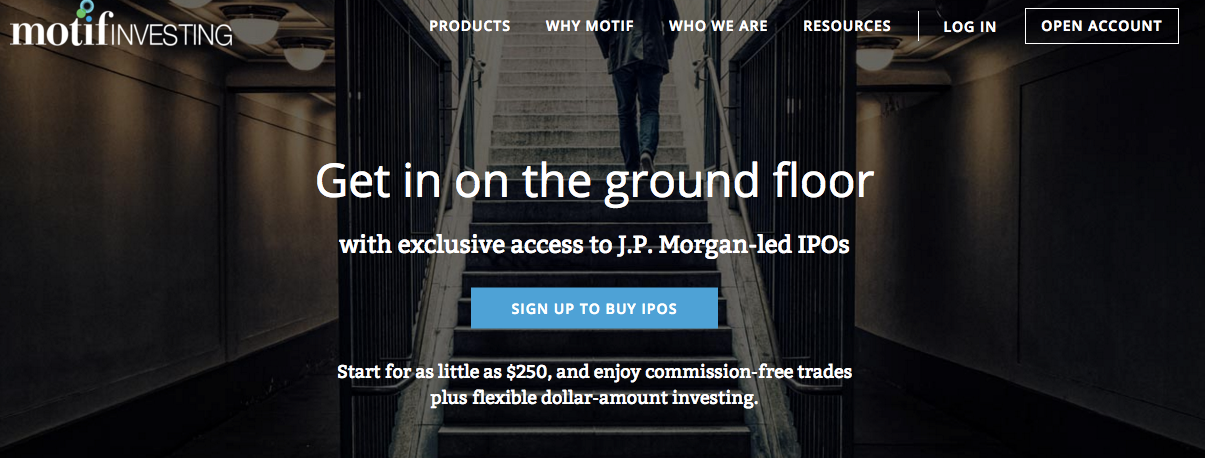
Since its launch, Motif Investing has championed creating low-cost, high-value portfolio creation tools for individual investors.
Founder and CEO of Motif, Hardeep Walia joined me on the Tradestreaming Podcast early in the company’s maturation cycle to talk about how Motif fits into the historical narrative of opening up investing tools and tech to individual investors:
So, what we do is we create indexes around these ideas and we focus on making investing very intuitive. It is as simple as, “I see something, an idea that I want. I want to put money to work and I don’t necessarily want to spend tons of time messing around with research in stocks, because I believe the index will do its job.” Then, we have very sophisticated investors who say, “You know what, just give me a starting point for a portfolio of stocks that actually act on these ideas,” and that’s what Motif is.
Motif announced today that it would take another step to opening up a traditionally opaque part of the investing world: IPOs. As part of a partnership with JP Morgan, the online broker is offering everyone access to IPO shares with as little as a $250 investment.
The new partnership “will broaden access to IPOs to more individual investors,” said Michael Millman, Co-Head of Americas Equity Capital Markets and Head of Technology Investment Banking at J.P. Morgan, in a statement. “Motif’s innovative and easy to use platform is a cutting-edge, differentiated way for issuers to reach investors.” J.P. Morgan will be encouraging its IPO companies to participate in the Motif program. Source
Motif appears serious in bringing its style of investing to the IPO market and it looks like JP Morgan may be the first of bulge bracket firms that bring offerings to the startup online broker.
IPO markets: Profitable, broken, and in need of fixing
IPOs have traditionally been a black box of the brokerage industry. “Book building” for IPOs, the process through which brokers went out to their clients to match supply and demand for shares, was completely opaque. Because IPO shares frequently pop after they list for trading, shares of top offerings were frequently reserved for the best customers of brokerage firms (high net worths and hedge funds).
In sought-after IPOs, it was very hard for general investors to get their hands on them. Because of such scarcity, investors requested larger than appropriate allocations for their portfolios in the hope that they’d end up with a better size allocation when the brokerage firms cut back their customers back . Because of this dynamic, in lackluster public offerings, investors frequently got “stuffed” with more shares than they really wanted.
The IPO process is one of the last holdouts in the face of digital disruption and that’s because IPOs play an important role in the brokerage business — they were a way for the brokerage firms to reward their best customers. Investment banks frequently underprice shares on their floats, providing quick profits to buyers of shares. The other side of this coin is that companies going public leave money on the table because of this underpricing. Investment banks come out looking good and brokerage firms are lauded by their customers.
Historically, there have been various attempts at disrupting the IPO process, including:
[x_icon_list]
[x_icon_list_item type=”dollar”]Dutch auctions: Investment bank, Hambrecht pioneered a form of dutch auction for IPOs, something it calls OpenIPO. In this model, the investment bank collects bids from all interested investors, big and small, and groups them by how much each is willing to pay for a share. Its bankers then count down from the top bid until they reach the highest price at which the selling company could sell all of the shares it wants to offer. The company can choose that price or, for various reasons, a lower one. Hambrecht then sells at the chosen price all the shares that were bid at that price or higher. One of the most famous IPOs to implement the OpenIPO process was Google, but few companies have really followed suit.[/x_icon_list_item]
[x_icon_list_item type=”dollar”]Equity crowdfunding platforms: With various new regulation in place (2012’s JOBS Act), the market has been kind of waiting to see equity crowdfunding platforms (like AngelList, CircleUp, and OurCrowd have popularized) perform the role of taking a private company into the public realm. It hasn’t quite happened, as regulation still relegates participation on crowdfunding platforms to accredited investors. It will take some more time before the general public will get a chance to transact in private companies.[/x_icon_list_item]
[x_icon_list_item type=”dollar”]Direct to consumer: There are a few firms like Cutting Edge Capital that working on Direct Public Offerings, a takeoff of the IPO but simpler and more accessible to general companies looking to list on a local exchange. Paperwork, filings are all easier to get going and it enables a company to market its securities to a local audience. Other firms, like Loyal3 , are creating investment platforms that make ease the IPO marketing for consumer brands and help them provide shares to loyal customers. Companies like GoPro and GoDaddy have used Loyal3 to distribute shares to their customers.[/x_icon_list_item]
[/x_icon_list]
Motif Investing’s approach is to create a personalized investing experience around individual investors. Individual investors can create thematic portfolios (called, motifs) and trade them with one click for a low fixed fee. Motif customers can share and implement company-built motifs or use those shared by others on the platform.
Who knows, maybe an IPO Motif is in the works.
[x_share title=”Share this Post” facebook=”true” twitter=”true” linkedin=”true” email=”true”]
[x_author title=”About the Author”]






